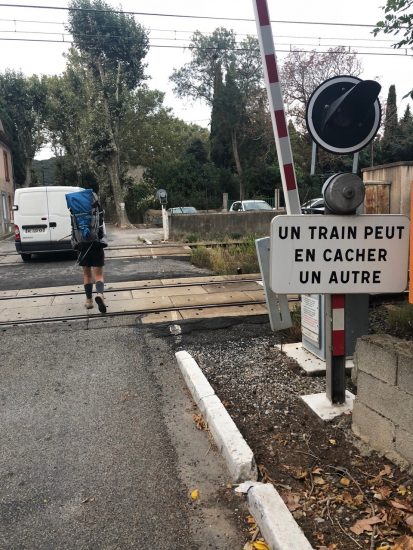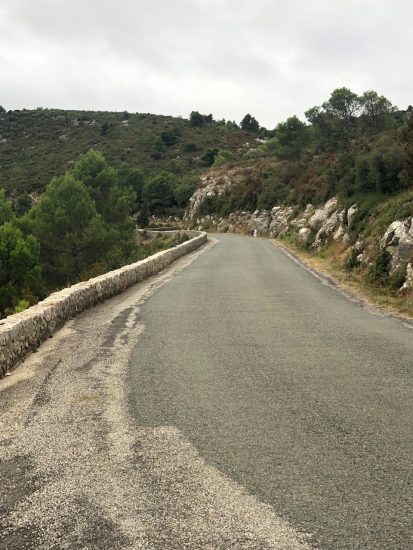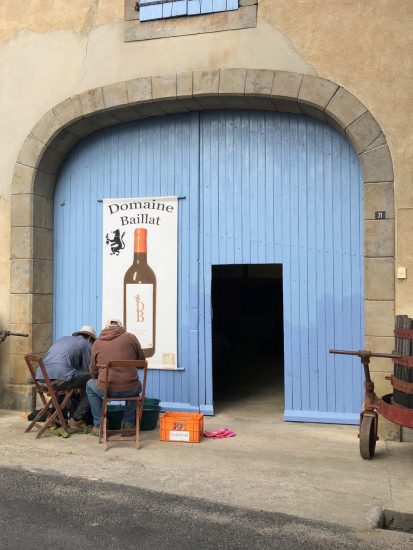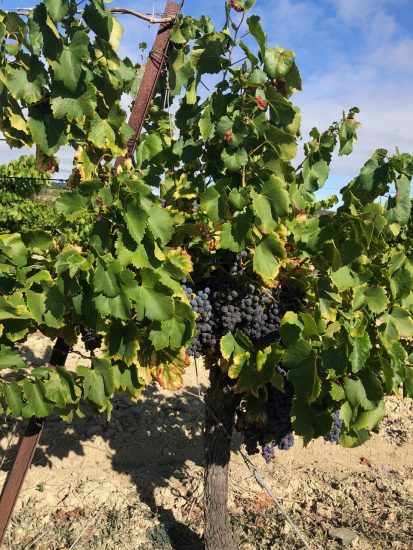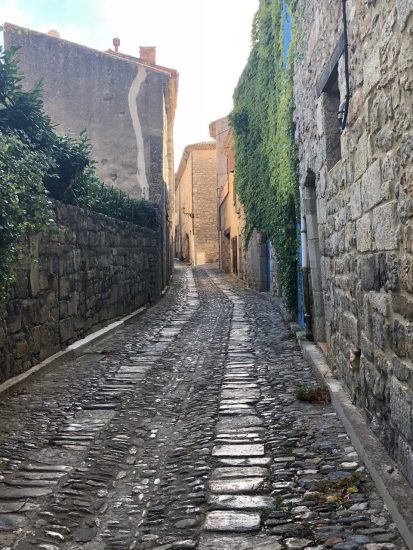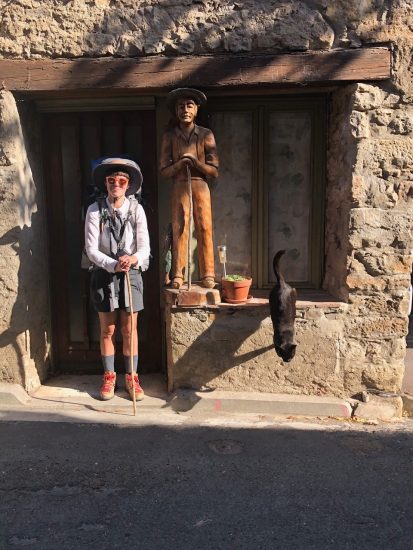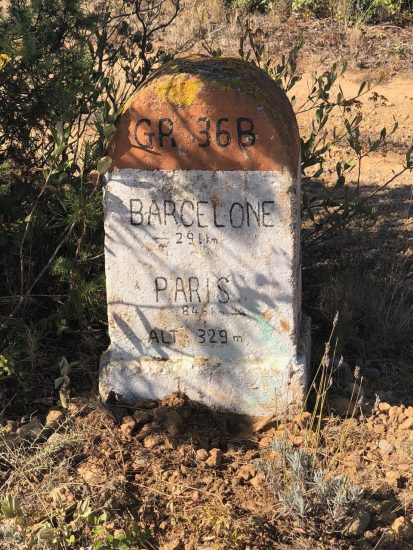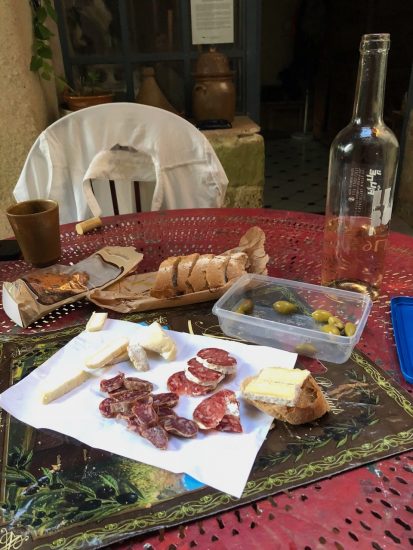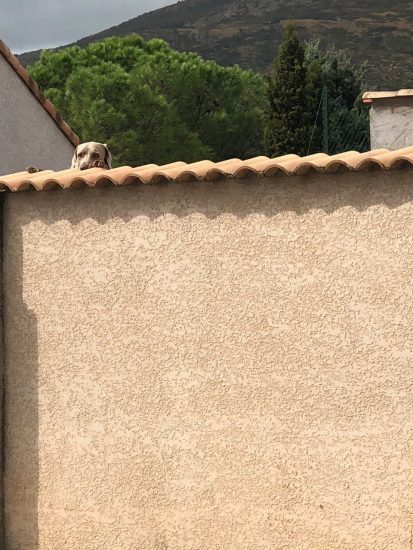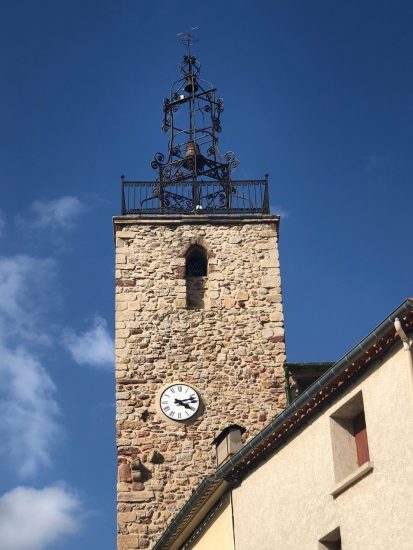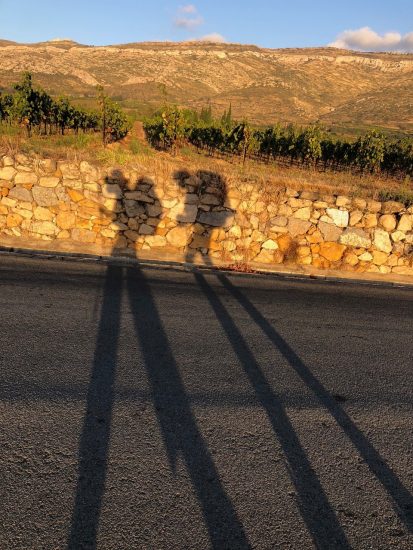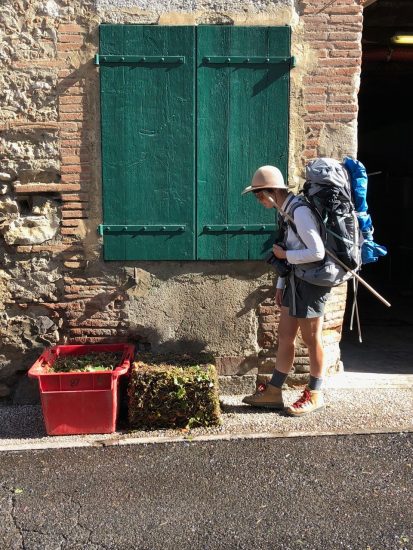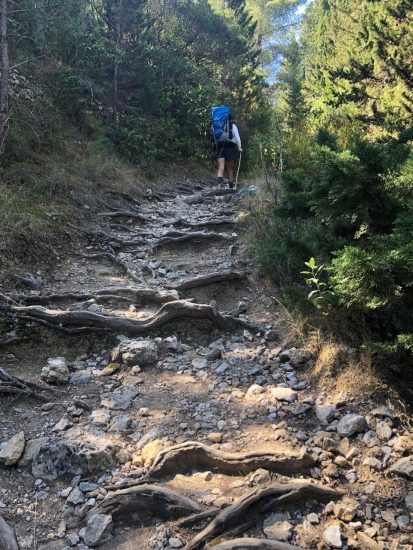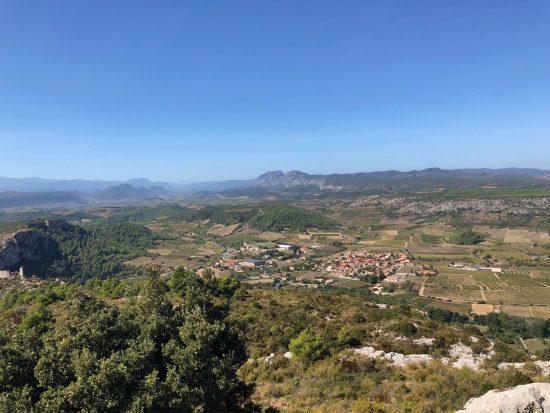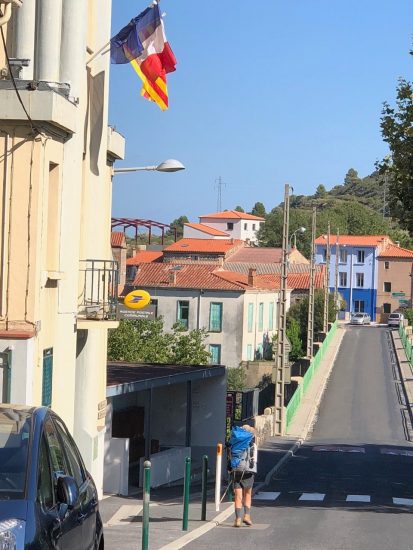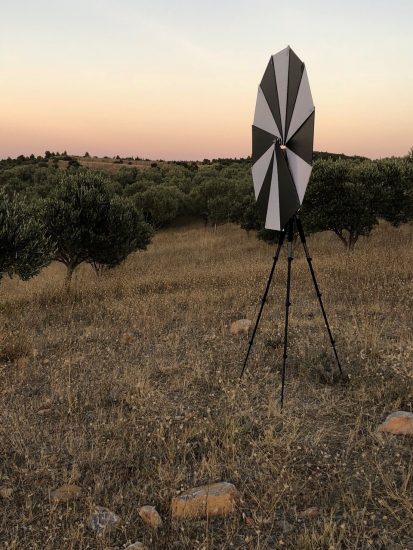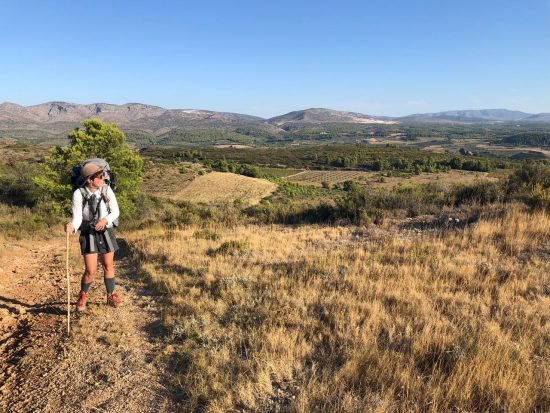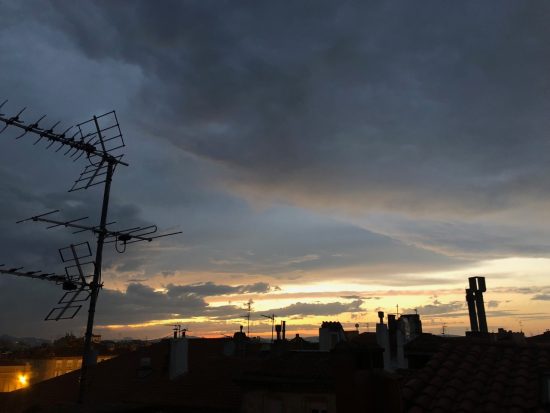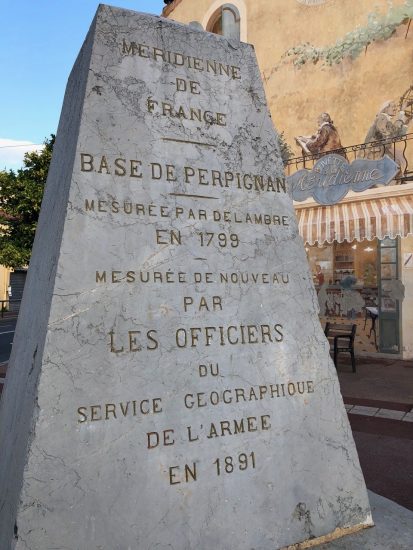On June 24 this year New York-based Australian artist, Sara Morawetz embarked on a 2000 kilometre walk through France and Spain for a performance titled étalon. During each week of the project she’s been accompanied by one of twelve collaborating artists and writers. In September Sharne Wolff joined Sara on the track from Carcassonne to Perpignan. During their time together they had many conversations. This is just one… Pictures by Sharne Wolff
Sharne: We’ve just been walking all day – nearly 25 kilometres – so tired as we both are, I thought I’d ask you for a brief description of étalon.
Sara: It’s always interesting to try and describe this project because it’s many things at the same time. Essentially, étalon is a durational walk where I am traversing the length of France and south into Spain. I’m following the journey of two French scientists who defined the length of the metre. In the 1790s these two scientists journeyed [along the Paris meridian] from Dunkirk to Barcelona in order to measure the curvature of the earth. They used this distance to get an understanding of the earth’s circumference and then created a metric that was one ten-millionth of the length from the North Pole to the Equator which is what the metre is, or was, historically meant to be.
Sharne: How did the idea for the project come about?
Sara: I found out about this historic journey about three years ago – I read the story as part of my PhD research. I was looking into concepts around the history and philosophy of science and concepts of standardisation – which is my thing, as crazy as that sounds – and in the moment I read it I knew it was a performance. I knew it was a work that needed to be made both conceptually rigorous and strong, and also poetic and simple. It needed to be a walk. I knew that in order to understand the metre in a way that I thought was possible, potential and necessary, I needed to walk this distance. I felt that in walking it would enable me to both understand the science and the labour of science – this enduring legacy that scientific methodology and scientific process requires.
Sharne: You’ve just completed Day 95 of the project and are around two weeks away from Barcelona and the end of the walk. In terms of endurance, how has the walk been a challenge? Do you feel that endurance has been an essential part of the walk, and the work?
Sara: The walk has been a challenge in every regard. I have been tested and tested time and time again. I feel like I’m tested every day in the act of getting up and deciding to walk again. I’ve been describing it as a physical, mental and emotional challenge. As for the endurance, in the first few weeks it was primarily physical – getting my body to a point where I could cope with the weight [Sara’s backpack of equipment and essential items weighs around 20 kilograms] and the walking day after day. It then became more mental and emotional as I dealt with the idea of what people’s perceptions of the walk would be, and what it is, and overcoming the barrier of having walked 1000 kilometres. There was a sense I needed to get far enough into it to both to be respected and to have achieved what I set out to. Reaching 1000 kilometres was an invisible marker for me. I had then done enough so whatever happened next it would be considered a large body of work. If I failed that would be fine. But prior to that point, there was a lot of emotional labour. I think now, towards the end, it’s a really mental position where I’m holding or suspending the desire to finish and to return home, and a desire to feel the end point and the conclusion with the loss of the work. That it is what it is.
Sharne: Like being afraid of the end?
Sara: Yes, being afraid of the end. And yes, there are so many things that I wish it was, that I wish I could have done, or I’d hoped it would be that it will not be. And there’s the grief and failure of that – and living with that as a constant reminder as you walk it out and knowing that you can’t do anything about it. That that’s the work.
Sharne: It’s interesting that given your incredible achievement that you still regard the work with a sense of failure?
Sara: [Laughs]. Absolutely.
Sharne: Do you think that idea is played out because you’ve walked so publicly – on social media and so on? Or is it more of a personal thing?
Sara: I think there’s an element of this weird double reading of how the work is perceived versus what it is perceived as. I mean, I can’t see it. The performance has been done for this series of people. It’s really only the twelve walkers who really know what the performance is because they’ve witnessed me do the performance. They’ve seen the best and worst of me and dealing with that kind of reality is hard. That’s the hard part. Then you have these people watching, and they’re watching in real time. There’s a failure to capture that experience, or to live up to that experience, or to live up to the idea that I have in my mind.
Sharne: It seems to me that the idea of failure that you’re describing would only be something that could be felt or described by a woman. Any male who’d walked 1800 kilometres as you’ve done wouldn’t be as likely, I don’t think, to publicly speak about it with a strong sense of failure. Do you think that sense of failure comes from being female?
Sara: Yes, probably. I’m not male so I can’t describe the alternate, but I can definitely perceive that it is a feminine quality. I wrote a series of comments that I sent out publicly which were quite honest and abrasive. They were real – things that I’d written down as I walked and thought about as I walked. And the feedback that I received was about how feminine they were, and how honest, and that gave it a sense of the feminist discourse that I’m trying to work through. It’s not the endurance and it’s not the action itself, it’s the fact that I’m willing to lay bare my fears and sense of failure even through the process. So yes, it is probably something to do with being a woman and being hypercritical of both the act of doing and the result of it. Even if you do succeed you can perceive all of the failures.
Sharne: All of the things that you might have done but didn’t do?
Sara: Exactly. Every day I see them. I think about whether I could have set up a measurement in a better place to get a better photograph. Could I have allowed more time to shoot something in that time? If I weren’t as exhausted as I was, would I have made better use of that experience? I can do it for every single day and do it every day. That’s all in there.
Sharne: You just mentioned the twelve people that you’ve walked with over the time, most of whom swapped week by week. So, what do you think that having all these different artists and writers and others along the road with you has brought to the work?
Sara: It’s brought an intense sense of energy and personal connection. It’s been so wonderful to get to know these people. They’re all incredibly smart, incredibly intelligent women who make exceptional work in their own right, and it’s a privilege that they would offer their time to come to this project and give their time to spend it with me. I feel that very acutely that they’ve offered so much. It’s an amazing thing that over a course of six days walking together – not that you’re talking about it – but you do form this quite strong bond so that at the end there’s the strange moment when you hand over to somebody else. And I can witness an arc with most people, but particularly people who haven’t walked [long distances] before. There’s the sense of trepidation and fear, then there’s this lull where they find it more emotional, more physical than they’d imagined. Then they rise through it and find that they can do it, and that they’re stronger and more capable in this regard. I feel their incredible sense of accomplishment in the task and getting to see that from these people I already admire is quite something. And then you have to let them go, and they disappear, and you reset. It’s like Groundhog Day.
Sharne: They disappear but they still become part of the work?
Sara: Absolutely… they’re within the work and they’ll always be within the work but it’s a strange moment where you hand over from one to the next. From what everyone has described they feel a sense of regret or sadness and you can feel the disconnect. And then you have to come back and start with the next person and it starts all over again.
Sharne: One of the more time-consuming parts of the work, but also one of the more interesting, is that you’re documenting it in a number of different ways. Do you want to explain how the work is being documented?
Sara: Sure. The most important way the work is being documented is through the measurements that are being done every day. We’re walking the landscape, walking from place to place, roughly following the meridian line that cuts through Paris. I’ve tried to shape the journey around the towns that the original French scientists visited although this has proved more difficult at certain times than others. We’ve gone slightly off-course to find accommodation, places with food and places that are easy to walk through but the walk is nonetheless shaped by that original journey. Every day – regardless of conditions – we must stop somewhere to take a measurement. That’s done with a GPS receiver taken from two points, a laser range-finder and a constructed target that allows me to measure across distance. These measurements are taken between 300–500 metres, the data from which is then processed in real time by my husband and collaborator, Darren Engwirda. Darren uses the data within a program he created to allow me to get a sense of what the earth’s circumference would be and what my measurement of the metre is. We do that measurement daily and that cumulative data will then become the metre that I make.
On top of that I have a daily task where I create a field report. Every day I record the details of that day – the temperature, humidity, distance travelled, cumulative distance, provisional metre length from the daily measurement of the metre, and some kind of observation from the field. These reports are sent through to the Musée des Arts et Métiers in Paris and are creating a cumulative field report. I also have a series of photographs that I take every day on the road. They represent a real time documentation of what I see and what the landscape looks like, a selection of which are posted to Instagram and a larger group to the website. At the moment, they’re just records of the field and I don’t know what they will become. Or if they will become anything. I wanted to give people a sense of what it looks like to walk through the landscape and to pass through a passage of time. I wanted to show the monotony of the landscape and the sudden shifts and subtle changes where you can actually witness time passing as you walk through these images. I think that part has been largely successful. People have come back to me and said things like the crops have gone, or the sunflowers have died, or the light is changing. There’s this notion of the repetition of it – more wheat, more grapes. All these things are the truth of what it is to walk through the landscape. You’ll see the same thing for a while and then it will change. Just subtly but significantly. The longer you do it the more of those things add together to become a picture of both time and space.
Sharne: That’s true. And as you say there’s all these subtleties, but there’s also a lot of drama as well isn’t there?
Sara: Absolutely. Particularly if you’re coming from northern France which is completely flat, and then through the Masiff Central and the Pyrenees, there’s a dramatic shift in landscape and that alters the range in which that sort of drama builds. Which is, I guess, the lovely part of travelling from north to south and suddenly we have these beautiful peaks and the dramatic way in which the light hits this landscape that it doesn’t in the north. During the performance I’ve witnessed a cross-section of France. I know what France looks like in the here and now. I can’t speak for what it will be in 6 months or in a year’s time, but I know what it looks like right now. And that’s been incredibly eye-opening. It’s been an anthropological study that was never intended but it is part of the work as well. Through these images you can get a sense of what this very narrow line down the middle of the country looks like. How towns feel. How people interact in those towns. There are areas of great economic prosperity or decline and they all sort of sit side by side and in twenty-kilometre intervals, which is quite surprising.
Sharne: What about the people along the way? I know today there were quite a few people we chatted to. What’s been the general reaction of the French people you’ve met along the way?
Sara: It’s astounding considering the basic level of my French – the one true failing of this project has been not being able to speak better French – how much they communicate and how incredibly engaged they are with the process. I think to start with, the French have a real affinity with walking, and walkers. I think they genuinely love to see people walking through their country and their landscape. They’re the first to yell out, ‘bon route’. The number of people that have stopped to offer me water, to offer shelter, to ask if I needed somewhere to eat, is just a day to day reality of walking through France let alone them understanding the context of why I’m doing it. So that’s incredible that there’s that level of generosity. People have stopped their cars to enquire if I’m a pilgrim. Am I going the right way? Did I need a lift to the next town? Am I. in need of anything? That happens… and then when you get the opportunity to explain what you’re doing and why you’re doing it, it’s quite remarkable. Some of them do know the history and the story and others don’t. Telling them about the history of their own country and the place that they’re in, you can see the pride that they feel. To them, the fact than an Australian, of all people, would want to come here and try and honour that legacy is amazing.
Sharne: Like those two women in the wine store this afternoon?
Sara: Yeah, like those women, they can see it as being worthy of something and they’re so excited that this is their story, that it’s part of France. Whether they enjoy the historical element, some people are just incredibly respectful of the walk’s duration element that it’s enough. It’s something they perceive of being worthy of something and they have a sense of respect. The art element of it becomes an interesting one again, depending on who you speak to and their level of engagement with conceptual or contemporary art. Some of them are just in love with it as an art work while others are a bit uncertain. Regardless, the enormity of the task is appreciated. I get emails from people I’ve met on the road who now follow me on my website and if I send something out, they’ll write to me. I think that’s an ongoing conversation which is really lovely.
Sharne: Do you feel like you’ve been a tourist on the walk?
Sara: I can tell you a wonderful list of places that I would highly recommend anyone to see, but I am lucky if I get 18 hours in any one place. My key concerns are where is our accommodation? Where will we get food? Is there a supermarket? And are we set up for both the evening and the morning to leave again? It’s a strange prism to view a place through. I have a cursory glance where I try and absorb the nature of a place – but whether they have a museum, or a beautiful church, if they have a nice set of stores is absolutely outside the view of what I need to do or the goals of my evening or afternoon. I have just walked anywhere between 15 and 35 kilometres – the last thing I need to do is find out the details of what kind of region I’m in.
Sharne: So, you’re absorbed in the landscape and the landscape absorbs you. But in terms of what’s going on around that, you remain undistracted?
Sara: As mentioned, walking through a place I get a keen perception of whether a town is on an economic rise or fall, whether there are people at work, if there’s large scale developments or rejuvenation happening and an overall feel of a place. There’s sense of whether it would be a lovely place to return to and the style of life of the people. These are the things that I actually enjoy when travelling anyway, so they are what I always look for more than I seek out monuments or museums. These are the things that interest me because they speak of the day to day life of any given place. I love looking at the markets every Saturday. So, on my rest day, that’s one of my favourite things – to walk through the markets and see people interacting. You learn so much about what life is like in this part of France and what life is like for these people. You see how they trade and what they trade. You’re able to witness the natural order of those movements and the performance of day to day life. But if you want to be specific about whether I’ve seen the notable tourist features – I’ve seen half a dozen and that’s it. If I were on holidays I wouldn’t have chosen the places I went to. They were serving a particular function and there was a hierarchy of functions. Trying to stay within the meridian line, trying to find somewhere that had accommodation and food and is within 20 kilometres of the last place I went to – this is the order of things. Anything outside that is a bonus. It’s not why I’m here. It’s not the work I’m here to do.
Those who walked with Sara Morawetz’ are: Connie Anthes, Boni Cairncross, Magali Duzant, Darren Engwirda, Kath Fries, Laura Hindmarsh, Chantal Meng, Lucy Parakhina, Alex Pedley, Stephanie Brotchie, Naomi Riddle and Sharne Wolff. Sara hopes to complete her epic walk in Barcelona at the end of this week. You can witness her walking progress and upcoming finish via Instagram @sara_blue. Further details of the étalon project are available at etalon-walk.com. [https://www.etalon-walk.com]
The étalon project has been assisted by the Australian Government through the Australia Council, its arts funding and advisory body, the QAGOMA Foundation through the Vida Lahey Memorial Travelling Scholarship, the Musée des Arts et Métiers, the Art Gallery of NSW, the Cité Internationale des Arts and Pratt Institute.
Sharne Wolff is currently researching Australian art and walking as part of her PhD research project at Macquarie University, Sydney.

